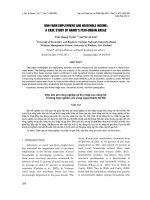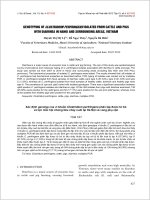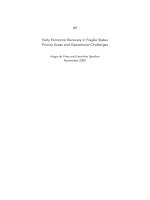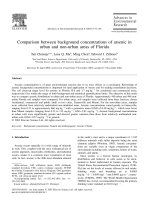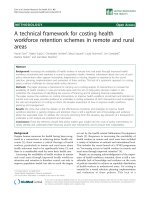Areas and logarithms
Bạn đang xem bản rút gọn của tài liệu. Xem và tải ngay bản đầy đủ của tài liệu tại đây (3.47 MB, 76 trang )
Areas and Logarithms
nOnYJUIPHhIE JlEKUHH no MATEMATI1KE
A. 11. Mapxyuresas
nJIOIUA)lJ1 11 JIOrAPM<1>MhI
H3M TEJIbCT80 «HAYKA» MOCKBA
LITILE MATHEMATICS LIBRARY
A.I. Ma.rkushevich
AREAS
AND
LOGARITHMS
·Translated from the Russian
by
I. Aleksanova
MIR PUBLISHERS
MOSCOW
First published 1981
Second printing 1987
Ha
aHZAUUCICOM Jl3WU
Printed in the Union ofSoviet Socialist Republics
â Tnaauas peAUIUIJI4ằB3Uo-MaTeMaTB1fCCKOH JlHTCpaTypLi H3.lUlTeJlhCTBa
ôHaysaằ, 1979
â English
translation, Mir Publishers, 1981
FOREWORD
I first presented the lecture "Areas and Logarithms" in the
autumn of 1951 at Moscow University to a large audience of
senior schoolchildren intending to participate in the Mathematics
Olympiad. 'The aim of the lecture was to present a geometric
theory of logarithm, in which logarithms are introduced as
various areas, with all the properties of the logarithms then
being derived from those of the areas. The lecture also introduced
the most simple concepts and elements of integral calculus,
without resort to the concept of a derivative.
The lecture is published in this booklet with some additions.
The reader can begin the book without even knowing what a
logarithm is. He need only have a preliminary knowledge of the
simplest functions and their graphical representation, of geometric
progressions, and of the concept of limit.
If the reader wishes to broaden his knowledge of logarithms
he is referred to the books The Origin of Logarithms by
I. B. Abelson and Series by A. I. Markushevich (in Russian). The
last chapter of the latter book contains an alternative theory of
logarithms to that presented here.
The present publication includes a Supplement in which Simpson's
rule and some of its applications can be found. In particular,
the nurnber 1t is calculated.
The author
1. Suppose a function is given which means that a method is
indicated which allows us to associate every value of x with a
corresponding value of y (the value of the function). Usually
functions are defined by formulas. For instance, the formula y = x 2
defines y as a function of x. Here, for every number x (say,
x = 3) the corresponding value of y is obtained by squaring the
number x (y = 9). The formula y = l/x defines another function.
Here for every nonzero x the corresponding value of y is the
number inverse to x; if x = 2 then y = 1/2 and if x = - 1/2
then y = - 2.
When we speak of a function without indicating what particular
function is meant we write y = f(x) (read "y is f of x"). This
means that y is a function of x (perhaps y = x 2 , or y = l/x,
or some other function). Recall the idea of number lettering:
the method just described closely resembles it, for we can speak
or of a number a,
either of the numbers 2, - 1/2,
understanding it as one of these or any other number. Just as
we use different letters to designate numbers, so we can describe a
function as y = f(x), or use some other notation, for instance
y = g(x), or y = h(x), etc. Thus, if a problem involves two
functions, we can denote one of them as y = f(x) and the other
as y = 9 (x), and so on.
The function y = f(x) can be shown graphically. To do this we
take two mutually perpendicular straight lines Ox and Oy - the
coordinate axes (see Fig. 1) - and, after choosing the scale unit,
mark off the values of x on the x-axis and the corresponding
values of y = f(x) on the lines perpendicular to Ox (in the
xOy plane). In so doing the rule of signs must be adhered to:
positive numbers are denoted by line segments marked off to the
right (along the x-axis) or upwards (from the x-axis) and negative
numbers are marked off to the left or downwards. Note that
the segments marked ofT from the point 0 along the x-axis are
called abscissas and the segments marked off from Ox at right angles
to it are called ordinates.
When the construction just described is carried out for all
possible values of x, the ends of the ordinates will describe a
curve in the plane which is the graph of the function y = f(x)
(in the case of y = x 2 the graph will be a parabola; it is shown in
Fig~ 2).
Take any two points A and B on the graph (Fig. 1) and drop
V2
6
from them perpendiculars AC and BD to the x-axis. We obtain a
figure ACDB; such a figure is called a curvilinear trapezoid.
If, in a special case, the arc AB is a line segment not
parallel to Ox, then an ordinary right-angled trapezoid is obtained.
And if AB is a line segment parallel to Ox, then the resulting
figure is a rectangle.
Thus, a right-angled trapezoid and a rectangle are special
cases of a curvilinear trapezoid.
y
o
x
b
Fig. I
o
x
Fig. 2
The graph of the function depicted in Fig. 1 is located above
the x-axis. Such a location is possible only when the values of the
function are positive numbers.
In the case of negative values of the function the graph is
located below the x-axis (Fig. 3). We then agree to assign a
minus sign to the area of the curvilinear trapezoid and to
consider it as negative.
Finally it is possible for the function to have different signs
for the different intervals of the variation of x. Its graph is then
located partly above Ox and partly below it; such a case is shown
in Fig. 4..Here the area A'C'D'B' of the curvilinear trapezoid
must be considered negative and the area A" C"D"B" positive.
If in this case we take points A and B on the graph, as shown
in the figure, and drop perpendiculars AC and BD from them to the
x-axis, we then obtain a figure between these perpendiculars which is
hatched in Fig. 4. The figure is called a curvilinear trapezoid,
as before; it is bounded by the arc AKA'B'LA"B"B, two
ordinates AC and BD and a segment CD of the abscissa axis.
We take as its area the sum of the areas of the figures ACK,
KA'B'Land LA"B"BD, the areas of the first and the third of them
being positive and the area of the second negative.
The reader will readily understand that under these 'Conditions
the area of the whole curvilinear trapezoid ACDB may turn out
7
to be either positive or negative, or in some cases equal to
zero. For instance, the graph of the function
y = ax (a > 0)
is a straight line; here the area of the figure ACDB (Fig. 5)
is positive for OD > DC, negative for OD < OC, and equal to
zero in the case of OD = OC.
y
y
o
c
D
x
x
Fig. 3
Fig. 4
2. Let us determine the area S of a curvilinear trapezoid.
The need to calculate areas arises so often in various problems of
mathematics, physics and mechanics that there exists a special
science - integral calculus - devoted to methods of solving problems
of this kind. We shall begin with a general outline of the
solution of the problem, dividing the solution into two parts.
In the first part we shall seek approximate values of the area,
trying to make the error in the approximation infinitely small;
in the second part we shall pass from the approximate values
of the area to the exact value.
First let us replace the curvilinear trapezoid ACDB by a stepped
figure of the type shown in Fig. 6 (the figure is hatched). It is
easy to calculate the area of the stepped figure: it is equal to
the sum of the areas of the rectangles. This sum will be
considered as being the approximate value of the sought area S.
When replacing S by the area of the stepped figure we make
an error ex; the error is made up of the areas of the curvilinear triangles blacked-out in Fig. 6. To estimate the error let us
choose the widest rectangle and extend it so that its altitude
becomes equal to the greatest value of the function (equal to
BD in the case of Fig. 6). Next let us move all the curvilinear triangles parallel to the x-axis so that they fit into that
rectangle; they will form a toothed figure resembling the edge of a saw
(Fig. 7). Since the whole figure fits into the rectangle, the error ex
8
equal to the sum of the areas of the saw teeth * must be less than
the area of the rectangle. If its base. is S we obtain Iell < S· BD.
Hence, the error a. can be made infinitesimal if the rectangles in
Fig. 6 are taken to be so narrow that the base S of the widest
of them is a sufficiently small number. For example, if BD = 20,
and we want the area of the stepped figure to differ from S by
less than 0.001, we must assume 8· BD = 208 to be less than
y
x
Fig. 5
Fig. 6
0.001, i.e. 8 < 0.00005. Then
Ia.1 < B· BD < 0.001.
Nevertheless, however small we make B, an error el will result
every time, if only a very small 0 ne, since the area of the
curvilinear trapezoid does not equal that of the stepped figure.
The second, and final, part of the solution of the problem consists
in passing to the limit. We assume that we consider not one,
and not two, but an infinite number of stepped figures such as
the one shown in Fig. 6. We take more and more rectangles,
increasing their number indefinitely, making the base 8 of the
widest rectangle smaller and smaller, so that it tends to zero.
The error el resulting from the replacement of the area of the
curvilinear trapezoid by the area of the stepped figure will
In Figs. 6 and 7 the graph of the function is like the slope up (or
down) a hill. Were the graph more complicated, with alternating rises
and descents (see, for instance, Fig. 4), then the curvilinear triangles
transferred into a single rectangle would overlap and the sum of their areas
could turn out to be larger than the area of the rectangle. To make our
reasoning applicable to this more complex case as well, let us divide the
figure into parts to make the graph, within the limits of a single part,
look like a single rise, or a single descent, and consider each part separately.
9
then become increasingly small, and indefinitely approach zero
as well. The required area S will be obtained as the limit of the
areas of the stepped figures.
3. Let us follow the reasoning used in Section 2 to estimate the
area of the curvilinear trapezoid in the very important special
case when the function y = f(x) is a power with an integral
nonnegative exponent y = xII:. For the exponents k = 0, 1, 2, we
obtain the functions y = XO = 1, y = Xl = X, Y = x 2 • Their graphs.
y
Fig. 7
are easy to construct: they are, respectively, a straight line
parallel to the x-axis and passing above Ox at a unit distance
(Fig. 8), a bisector of the angle xOy (Fig. 9), and a parabola
(Fig. 10).
If we use higher exponents, we obtain the functions y = x 3 ,
Y = x", Y = x 5 • These graphs are shown in Figs. 11, 12 and 13.
If k is an odd number, the graphs are symmetrical with
respect to the point 0 (Figs. 9, 11, 13), and if k is an even
number, then they are symmetrical with respect to the y-axis
(Figs. 8, 10, 12).
If k ~ 1, the graphs pass through the point O. In this case the
greater the value of k, the closer the graphs are to the x-axis
in the proximity of the point 0 and the steeper they rise
upwards (or fall downwards) as they recede from the point o.
Each of the figures 8-13 contains a hatched curvilinear trapezoid.
The areas of these trapezoids are easy to find when k = 0
and k = 1. Indeed, if k = 0, the area of. ACDB is equal to CD· AC =
= (b - a)·1 = b - a; if k = 1, then the area of ACDB is
2 - a2
CD. AC+BD =(b_a)a+b = b
222
10
x
y
Fig. 11
y
b
Fig. 12
II
Let us prove that if k == 2, the area of ACDB is equal to
b3 _ a 3
b4 - a4
3 -; ~~ k = 3, the area of ACDB is
4
,etc. We shall
prove that in the general case, when k is any integral nonnegative
number, the area of the corresponding curvilinear trapezoid is
b"+ 1 _ ak + 1
equal to
k+1
. It is evident that this general result
covers all the special cases discussed above.
y
8
Fig. 13
To make it easier to follow the calculations below let us assume
a definite numerical value for the exponent k, say k = 5. Let
us further suppose that 0 < a < b. Consequently we refer to the
graph of the function y = x 5 and, following the reasoning
outlined in Section 2, prove that the area of the curvilinear
6
trapezoid ACDB (Fig. 14) is equal to b
~a
6
•
4. We have to calculate the sum of the areas of the very
large number of rectangles which make up the stepped figure
(Fig. 14). To simplify our job we choose the rectangles so
that their areas form a geometric progression. To do this
we take the points E, F, G, H, ... , 1 on the x-axis so as to
make the line segments OC = a, OE . OF, OG, ... , OJ, OD = b
form a geometric progression: we designate the number of terms in
this progression by n + 1 and its common ratio by q (since
12
b > a, q > 1). Then we have the equalities
OC = a, OE = aq, OF = aq",
OG= aq 3,
••• ,
OI=aq"-l,
OD±:aq"=b.
Fig. 14 depicts six rectangles and hence n + 1 = 7, but we
shall suppose in what follows that n is an arbitrarily large number,
say n = 1000, 10000, 100000, etc.
y
8
x
Fig. 14
The bases of the rectangles form a geometric progression with
the same common ratio q:
CE=OE-OC=a(q-l),
EF=OF-OE=aq(q-l),
FG=OG-OF= aq2(q-l), ... ,
JD = OD - OJ = aq"-l(q - 1)
13
(the number of terms in this and the following progressions
is equal to n and not to n + 1).
The altitudes of the rectangles are the ordinates CA, EE h
FF i - GGb ... , I 11; each of them is equal to the fifth power of the
abscissa corresponding to it (remember that we have assumed
y = x 5 ). Hence
CA
= OC 5 = as,
EEl
= OE 5 = a 5q 5, FF 1 = OF 5 = a 5q l 0 ,
GG 1 = a5 q l 5, ... , III = 01 5 = a 5q S(n -
l ).
We see that the altitudes of the rectangles also form a geometric
progression with the common ratio q5 (= qk).
Since the bases of the rectangles form a progression with
the common ratio q and the altitudes form a progression with the
common ratio q5 (= qk), the areas of the rectangles must form a
progression with the common ratio qq5 = q6 (= qk+ 1):
CEo CA = a(q - l)a 5 = a6(q - 1);
EF.EE 1 = aq(q - 1}a5 q 5 = a6 q6(q - 1);
FG· FF 1 = aq2(q - l)a 5 q l 0 = a6 q12 (q - 1);
ID· III = aq"-l (q - 1)a5 q 5(n -
l)
= a 6q 6(n -
l) ( q -
1).
Therefore the sum of the areas of the rectangles equal to the
area of the stepped figure is the sum of the geometric progression
with the first term a6(q - 1), the last term a 6 q 6(n - 1) (q - 1) and
the common ratio q6:
a6 q 6
l ) (q _
1)q6 - a6 (q - 1)"
q6 _ 1
= [(aqn)6 =
q5
a
. q- 1
6]
q6 _ 1
=
b6 - a6
+ q4 + q3 + q2 + q
q6 _ 1
- - = q5
( we have used the equalities b = ao" and q- 1
+ q3 + q2 + q +
+1
+ q4 +
1).
5. Let us increase indefinitely the number of the rectangles n.
Since the bases of the rectangles form an increasing geometric
progression (q > 1), the first one must be the smallest. But the sum
of the lengths of all the n bases is equal to b - a; therefore
14
b-a .
b-a
the length of CE is less than - - , 1 . e. aq - a < --, whence
n
n
b-a
q-l<--.
na.
The right.. hand side of the last inequality tends to zero when n
increases indefinitely; since the left-hand side is positive it must
tend to zero too, that is, q tends to unity.
This implies that q2, s'. q4 and q5 also tend to unity,
the sum q5 + q4 + q3 + q2 + q + 1 tends to 1 + 1 + 1 + 1 + 1 + 1 =
= 6 and, hence, the whole area of the stepped figure, equal to
b6 - a6
tends to the limit
The required area of the curvilinear trapezoid must equal that
particular limit:
b6 - a6
s= --6--.
We have obtained this result for k
= 5. If we were to make these
calculations in the general case for any natural k, we would
obtain
bi + 1 _ ak+ 1
S=-----
k+ 1
Thus we have proved that the area of the curvilinear trapezoid
bounded above by the arc of the graph of the function
y = xk and located between two ordinates with the abscissas a and b
.
b"+ 1 - a"+ 1
IS equal to
k+1
.
6. We obtained the results of the previous section assuming
that 0 < a < b, i. e. that the curvilinear trapezoid lies to the right
of the y... axis. If a < b < 0, the proof is carried out in the same way.
However, assuming the common ratio q of the progression to be
positive and greater than unity as before, we must now take b as
the first and a as the last term of the progression (since
lal> IbO. Repeating the computations we receive the same result:
s=
bk+ 1 _ ak+ 1
k+ 1
15
If k is an odd number, then k + 1 is even and, hence, bk + 1
and a k + 1 are positive numbers, the first number being less than the
second. Therefore, in this case S is expressed by a negative
number. This is clearly to be expected, since for odd k the
corresponding curvilinear trapezoid lies below the x-axis (see the
left-hand parts of Figs. 11 and 13).
Let us return to the case 0 < a < b. If we consider b to be
invariable and make a tend to zero, then the -curvilinear
trapezoid will extend to the left, and for a equal to zero
will turn into a curvilinear triangle OBD (Fig. 15) (we assume
that k ~ 1). It is obvious that for a tending to zero the area of the
y
K
L
Fig. 15
curvilinear trapezoid will tend to the area of the curvilinear
triangle. Indeed, the difference between the second and the
first area will be less than the area OeAL, which itself tends to zero.
On the other hand, for a tending to zero, the area of the
b"+l
.
curvilinear trapezoid tends to - - , as is seen from the obtained
k+1
formula. Therefore the area of the curvilinear triangle ODB is
bk+ 1
equal to k
+
l'
i. e. it is k
+1
times less than the area of the
rectangle ODBK, or, the same thing, k + 1 times less than the
product of the "legs of the right-angled triangle" ODB (we have
put inverted commas since we speak here not of the ordinary
triangle, but of the curvilinear one). For k = 1 we have a function
y = x, with the graph becoming a straight line (see Fig. 9)
and the triangle an ordinary right triangle with its area equalling
1
1
.
1+1 ="2 of the product of the legs.
16
We obtain analogous results if we proceed from the assumption
a < b < 0 (the curvilinear trapezoid is located to the left of Oy).
Taking a to be invariable we make b tend to zero; then the expression
ak,+l
blc+ 1 _ ak + 1
k+1
tends to the limit - 1+1. This will be exactly the
area of the corresponding curvilinear triangle.
A curvilinear triangle can be considered as a special case of a
curvilinear trapezoid. From .what we have established it follows
that the formula
remains valid for a curvilinear triangle as well. We need only put
in it a = 0 (if the triangle lies to the right of Oy) or
b = 0 (if the triangle lies to the left of 0 y).
7. Let us return to the general problem of the areas of curvilinear
trapezoids. Let ACDB be a curvilinear trapezoid bounded by the arc
y
o
Fig. 16
AB of the graph of the function y = j(x), two perpendiculars AC
and BD dropped from the end points of the arc to the
x-axis, and by the segment CD of the line Ox intercepted
by the feet of the perpendiculars (Fig. 16). If OC = a and OD = b
with a < b, then the area ACDB is designated
b
Jf(x)dx.
Every detail in this designation has a definite meaning, Here we have
a function f(x) whose graph is the upper part of the boundary
of the curvilinear trapezoid, and also the numbers a and b,
17
specifying the right part and the left part of the boundary.
The designation (*) defines the method of seeking the area of
ACDB; this method was given in Sections 2 and 3 and involves
calculating the sum of the areas of the rectangles constituting
is
the stepped figure and passing to the limit. The sign
the extended letter S, the initial letter of the Latin word summa,
sum. The unusual shape of the letter S implies that the calculation
of the area of the curvilinear trapezoid involves not only summation,
but must also .include the passage to the limit. To the right
of the sign S, which is called the integral sign (from the
Latin integer meaning full, entire), is the productf(x) dx. It represents
the area of the rectangle with altitude f(x) and base dx. The
letter d standing before x is the initial letter of the Latin word
differentia meaning difference; dx denotes the difference between
the two values of x (see Fig. 16): dx = x' - x, The number a
is the lower limit and b the upper limit of the integral (here
the word "limit" means "boundary").
Thus, the designation (*) for the area of the curvilinear
trapezoid carries, on the one hand, all the information concerning
its form and dimensions (given by the numbers a and b and by
the function f(x)), and, on the other hand, contains within it the
method of seeking the area of the trapezoid by calculating
the areas of the rectangles with altitudes f(x) and bases dx, by
summing these areas and by passing to the limit (the integral
sign shows that the summation and passing to the limit must be
carried out). The designation (*) should be read as "the integral
from a to b, f of x dx". We repeat once again that this
designation expresses the area of the curvilinear trapezoid ACDB.
Using the new designation we may express the results of Section 5
as follows:
J
b
b"+ 1 _ a"+ 1
Jxkdx= - - - - a
k+1
(k is an integra) nonnegative number). The last equation should
be read as "the integral from a to b of xl' dx is equal to the
difference b"+ 1 and ak.+ 1, divided by k + 1".
8. Let us define some simple properties of integrals. Obviously the area ACDB added to the area BDD'B' yields the
area ACD' B' (Fig. 17). But the first area is equal to
b
e
e
S.f(x)dx, the second to Jf(x) dx, and the third to Jf(x) dx;
b
18
b e e
therefore we have Jf(x)dx
Q
+ If(x)dx = If(x)dx.
.
b
a < b < c:
Here
Q
now if a < c < b (Fig. 18), then, taking into account that the areas
ACD'B' and B'D'DB together yield the area ACDB, we obtain
e b b
If(x)dx + ff(x)dx = Jf(x)dx.
C
Q
Q
b
In introducing the concept of the integral Jf(x)dx in Section 7
a
we assumed that a < b, i. e. that the lower limit is less than the
y
c
o
o
x
o
a
Fig. 17
x
COD
b
Fig. 18
upper limit. That is why
the
area BDD'B', where
OD
=b
c
and OD' = c for
b < c (Fig. 17), was
written
as
Sf(x)dx
b
b
and for b > c (Fig. 18) as If(x)dx (every time the lower limit
is less than the upper limit). In the first case the difference
c
c
b
between the integrals Jf(x)dx - Jf(x)dx was equal to Jf(x)dx, and
Q
b
Q
b
in the second case to Jf(x)dx (we have made use of the equalities
of the integrals written above). To be able to express both cases
by the same formula we shall agree that for b > c we may write
c
b
Jf(x) dx = - Jf(x) dx.
b
19
In other words, we shall now include an integral whose lower
limit is greater than the upper limit, meaning by this the area of a
curvilinear trapezoid taken with the opposite sign. Then, instead
of the two different formulas
c
c
b
Sf(x) dx - Sf(x) dx
a
Sf(x) dx (b < c)
=
b
Q
and
e b b
Jf(x)dx - Jf(x)dx
Jf(x)dx
= -
(b > c)
Q
Q
we shall write in all cases
c
b
t
Sf(x)dx - Jj(x)dx
= Jf(x)dx
(b =1= c).
b
Q.
For b == c the left..hand side vanishes; therefore it is legitimate
b
to consider the integral Jf(x) dx, assuming it to be equal to zero.
b
Thus, irrespective of whether b <
use the formula
c
b
Jf(x) dx - Jf(x) dx
Q
b > c or b = c, we can
C,
t
=
Jf(x) dx
b
Q
in all cases. This formula can also be written as follows:
b e e
Jf(x)dx + Jf(x)dx
a
b
=
Jf(x)dx.
a
We leave it to the reader to verify, with the results established
in this Section, that the formula
b
bk + 1 _al+1
Jx"dx= - - - k+1
Q
is valid for any a and b (and not only for 0 ~ a < b or
a < b ~ 0).
9. Assume that f(x) is written as the sum or the difference of
two functions:j(x) = g(x) + h(x) or f(x) = g(x) - h(x) (for example,
f(x) = x 3 - X S). Then the integral of f(x) can be replaced by the
sum or the difference of the integrals of the functions g (x) and
20
h(x):
b
Sf(x)dx
=
II
!
(or !!(X)dX = g(x)dx b
b
b
II
a
Sg(x)dx + Jh(x)dx
!
h(X)dX). For example,
b
b4
b
J(x 3 - x S)dx=Jx 3 d x - J x sdx=
o
a
_
-
4
a
b6
a4
_
a6
6
Let us prove this property of integrals, taking the case of the sum.
Letj(x)=g(x)+h(x); the graphs of the three'functions g(x), h(x)
'and f(x) are depicted in Fig. 19. We have to prove that
b
Jf(x)dx
II
=
b
b
II
"
Jg(x)dx + Sh(x)dx,
that is, that the area of ACDB is equal to the sum of the areas
of AtCtD1B 1 and A 2C 2 D2 B 2 • Let us divide the segment of the
x-axis between the points x = a and x = b into parts and construct
the corresponding stepped figures for the three curvilinear
trapezoids depicted in Fig. 19. It is evident that the area of each
rectangle in the lower part of the figure is equal to the sum of the
areas of the two rectangles shown in the two upper parts of the
figure. Therefore the area of the lower stepped figure is equal
to the sum of the areas of the two stepped figures lying
above. This connection between the areas of the stepped figures
will remain no matter how we divide the interval on the x-axis
between x = a and x = b. If this interval is divided into an
indefinitely increasing number of parts whose lengths tend to zero,
b
then the
lower area
will tend to
the
limit
Sf(x) dx and
the two parts lying above will tend to the limits
b
b
Jg(x)dx and Jh(x)dx.
II
II
Since the limit of the sum is equal to the sums of the limits,
b
Jf(x)dx
II
b
b
b
II
II
II
= J[g(x) + h(x)]dx = Jg(x)dx + Jh(x)dx;
and that is what we had to prove.
21
In just the same way it can be proved that
"
J[g(X) -
b
Jh(x)dx.
a
a
h(x)ldx = Jg (x)dx -
Q
b
It is easy to see that this property of integrals is also valid
when f(x) is the sum of the greater number of summands. For
o
c,
0,
b x
a
x
Fig. 19
example, if f(x) = g(x) - h(x)
+ k(x), then
b
J[g(x) - h(x) + k(x)]dx =
b
=
J[g(x) - h(x)]dx
ClI
b
+ Jk(x)dx
=
22
=
ClI
b
b
b
ClI
a
ClI
Jg(x)dx - Jh(x)dx + Jk(x)dx.
10. We have also to find the connection between the integrals
b
b
Jf(x) dx and
JCf(x) dx,
Q
Q
where C is some (constant) number; for instance, we have to find
b
the connection between the integrals
Jx 3 dx
b
and
J2x.3 dx.
Let
Q
us show that
b
JCf(x)dx =
b
C Jf(x)dx,
Q
Q
for example,
b
Ja 2x
3
b4
b
dx
= 2 Jx 3 dx
a
_ a4
= 2--4
To simplify the reasoning we shall give to C a definite numerical
1
value, say, C = 2. Now we have to compare the integrals
f~
b
!f(X)dX and
f(x)dx.
Fig. io depicts the curvilinear trapezoids whose areas are represented
by these integrals. Let us divide the segment of the x-axis
between the points x = a and x = b into a number of parts and
construct the corresponding stepped figures. It is easy to see that
the area of each rectangle in the lower part of the figure is equal
to half the area of the rectangle lying above it (from the upper
part of the figure). Therefore the area of the lower stepped
figure is half that of the upper stepped figure. Passing to the
limit as we did in Section 9, we conclude that the whole area
of the lower curvilinear trapezoid is also half the area of the upper
curvilinear trapezoid:
b
f
lIb
2"f(x)dx = 2"!f(x)dx.
In our argument the number C was positive; if we assume C
23
